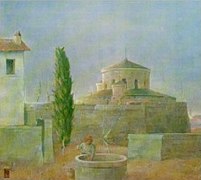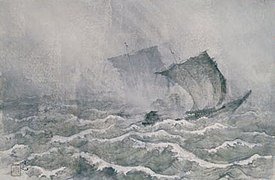Irie Hakō
Irie Hakō ( Japanese 入 江 波光 , actual first name Ikujirō (幾 治郎); born September 26, 1887 in Kyōto ; died June 9, 1948 ) was a Japanese painter of the Nihonga direction of the Taishō and early Shōwa periods .
life and work
Irie Hakō received his first painting lessons from Morimoto Tōkaku (森 本 東 閣; 1877-1947) in 1902, then attended the "Municipal School for Arts and Crafts" (京都 市立 美術 工 芸 学校; Kyōto shiritsu bijutsu kōgei) in the same year in Kyōto gakkō). After graduating in 1907, he worked in the study department he school, but changed in 1909 with the establishment of the "Municipal College of Art" (京都 市立 絵 画 専 門 学校; Kyōto shiritsu kaiga semmon gakkō) to this. There he graduated two years later, in 1911. In 1913 he was sent from his school to Tōkyō to gain experience at the local art school and the Imperial Museum. Among other things, he made a copy of Katsukawa Shunshō's "Seven Beauties in the Bamboo Grove" (竹林 七 妍 人; Chikurin shichi kennin). In that year he painted the picture “Furisode Great Fire” (振 袖 火 事, Furisode kaji): the title refers to the Meireki Great Fire in Edo in 1657.
1918 Irie was asked by Sakakibara Shihō (1887–1971), Murakami Kagaku and others to participate in the exhibitions of the "Creative Society for National Images" (国画 創作 協会, Kokuga sōsaku kyōkai). He exhibited the picture "A hermitage next door" (隣 案, Rin'an) and received a prize from the society and was accepted as a member. The other pictures he exhibited there include “Village by the Sea” (臨海 の 村, Rinkai no mura) on the 2nd and “On the other bank” (彼岸, Higan) on the Society's 3rd exhibition.
In 1922 Irie was sent from the city of Kyoto to Europe, where he dealt with the classical painting there in Italy, but especially in Spain. “Landscape in Southern Europe (Church of St. Constance)” (南欧 小 景 (聖 コ ン ス タ ン ツ ァ 寺) Nan'ō shōkei (Konsutantsua-ji)) and “Blue Forest” (蒼 林, Sōrin) are examples from this period. - In 1940, at the request of the Ministry of Culture, he worked at the Hōryū-ji Temple in Nara Prefecture and made copies of the wall paintings in the main hall. But he died before he could finish this job.
photos
Remarks
- ↑ Higan means, on the one hand, the equality of day and night in spring and autumn, but also the passage into another world.
literature
- National Museum of Modern Art, Kyoto (ed.): Irie Hakō. In: Kyōto no Nihonga 1910–1930. National Museum of Modern Art, Kyoto, 1986. ISBN 4-87642-117-X .
- Laurance P. Roberts: Irie Hakō . In: A Dictionary of Japanese Artists. Weatherhill, 1976. ISBN 0-8348-0113-2 .
Web links
| personal data | |
|---|---|
| SURNAME | Irie, Hakō |
| ALTERNATIVE NAMES | 入 江 波光 (Japanese); Irie Ikujirō (real name); 入 江 幾 治郎 (real name, Japanese) |
| BRIEF DESCRIPTION | Japanese painter |
| DATE OF BIRTH | September 26, 1887 |
| PLACE OF BIRTH | Kyoto |
| DATE OF DEATH | June 9, 1948 |





